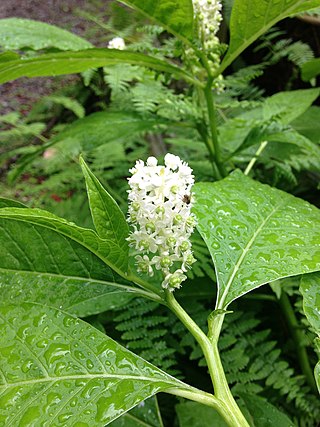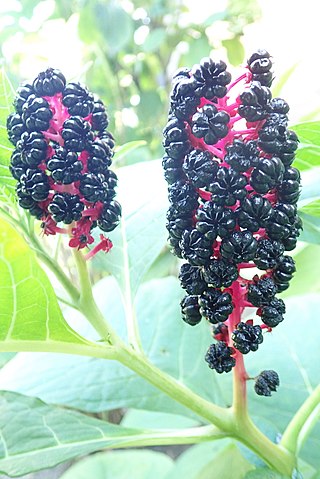
Phytolacca is a genus of perennial plants native to North America, South America and East Asia. Some members of the genus are known as pokeweeds or similar names such as pokebush, pokeberry, pokeroot or poke sallet. Other names for species of Phytolacca include inkberry and ombú. The generic name is derived from the Greek word φυτόν (phyton), meaning "plant," and the Latin word lacca, a red dye. Phytolaccatoxin and phytolaccigenin are present in many species which are poisonous to mammals if not prepared properly. The berries are eaten by birds, which are not affected by the toxin. The small seeds with very hard outer shells remain intact in the digestive system and are eliminated whole.

Phytolacca dioica, commonly known as ombú in Spanish and umbu in Portuguese, is a massive evergreen tree in the Pokeweed Family (Phytolaccaceae) native to the Pampas of South America. As its specific epithet suggests, it is dioecious, with male and female flowers on separate plants. The flowers are pollinated by the butterfly Doxocopa laurentia. It has an umbrella-like canopy that spreads to a diameter of 12 to 15 meters and can attain a height of 12 to 18 meters. This upper growth springs up from a tuberous caudex which, according to Everett "may occupy a circle sixty feet [18 meters] in diameter". One tree of such a size is mentioned by Anglo-Argentine writer William Henry Hudson in his autobiography " Far Away and Long Ago", which was fifty feet girth above the caudex. Because it is derived from herbaceous ancestors, its trunk consists of anomalous secondary thickening rather than true wood. As a result, the ombú grows fast but its wood is soft and spongy enough to be cut with a knife. These properties have led it to be used in the art of bonsai, as it is easily manipulated to create the desired effect. Since the sap is poisonous, the ombú is not grazed by cattle and is immune to locusts and other pests. For similar reasons, the leaves are sometimes used as a laxative or purgative. It is a symbol of Uruguay, Rio Grande do Sul and Argentina, and of gaucho culture, as its canopy is quite distinguishable from afar and provides comfort and shelter from sun and rain.

Phytolacca icosandra, sometimes known as button pokeweed or tropical pokeweed, is a species of flowering plant found in the neotropics and introduced into the warmer areas of the western USA.

Phytolacca americana, also known as American pokeweed, pokeweed, poke sallet, pokeberry, dragonberries, and inkberry, is a poisonous, herbaceous perennial plant in the pokeweed family Phytolaccaceae. This pokeweed grows 1 to 3 metres. It has simple leaves on green to red or purplish stems and a large white taproot. The flowers are green to white, followed by berries which ripen through red to purple to almost black which are a food source for songbirds such as gray catbird, northern mockingbird, northern cardinal, and brown thrasher, as well as other birds and some small non-avian animals.

Phytolaccaceae is a family of flowering plants. Though almost universally recognized by taxonomists, its circumscription has varied. It is also known as the Pokeweed family.
Pokeweed mitogen is a mitogen derived from the roots of Phytolacca americana. It functions as a lectin and a mitotic stimulus for the division of lymphocytes.
Taplitumomab paptox is a mouse monoclonal antibody. The antibody itself, taplitumomab, is linked to the protein PAP, an antiviral from Phytolacca americana, a species of pokeweed. This is reflected by the 'paptox' in the drug's name.
Inkberry is a common name for several unrelated plants:

Callisia is a genus of flowering plants in the spiderwort family, Commelinaceae. Members of the genus are commonly known as roselings. It is native to the Western Hemisphere from the southern United States to Argentina. The generic name is derived from the Greek word κάλλος (kallos), meaning "beauty."

Astragalin is a chemical compound. It can be isolated from Phytolacca americana or in the methanolic extract of fronds of the fern Phegopteris connectilis. It is also found in wine.

Phytolacca octandra, also known as inkweed or red inkplant, is a herbaceous perennial plant in the pokeweed family Phytolaccaceae, originating from the Neotropical realm of the Americas.

Phytolacca sandwicensis, also known as Hawai'i pokeweed, is a member of the Phytolaccaceae family and is a flowering and fruit bearing species endemic to the Hawaiian Islands, where it is found on Kauaʻi, Oʻahu, Molokaʻi, Maui, and Hawaiʻi. Locally it is referred to as pōpolo kū mai and/or pōpolo.Pōpolo itself is a term for any Solanum species, which its berries resemble.
Phytolacca pruinosa, the Levantine pokeweed, is a species of plant in the Phytolaccaceae family. It is a perennial bearing green flowers which become red on maturity. Fruits are black berries.

Caffeic aldehyde is a phenolic aldehyde contained in the seeds of Phytolacca americana. It is present in various parts of a large number of plants, such as the seeds of Phytolacca americana.

Phytolacca japonica is a species of flowering plant in the pokeweed family (Phytolaccaceae). It native to eastern Asia, where it is found in China and Japan. Its natural habitat is in forests edges, in ravines and along riversides.

Phytolacca acinosa, the Indian pokeweed, is a species of flowering plant in the family Phytolaccaceae. It is native to temperate eastern Asia; the Himalayas, most of China, Vietnam to Japan, and has been widely introduced to Europe. The species was originally described by William Roxburgh in 1814.
Pokeweed may refer to several species of genus Phytolacca:
Pokeweed mosaic virus is a species of virus in the genus Potyvirus. It is known to infect American pokeweed, in which it causes mosaic symptoms.
Phytolacca heterotepala, the Mexican pokeweed, is a species of plant in the pokeweed family Phytolaccaceae. It is native to the state of Tamaulipas in northeast Mexico and has been introduced to the U.S. state of California and Portugal.

Anthurium amoenum is a species of Anthurium found in Bolivia, Colombia, Ecuador, Peru, and Venezuela













